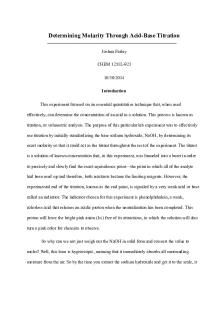Analysis of Antacid through back Titration PDF

| Title | Analysis of Antacid through back Titration |
|---|---|
| Author | Angie Pratte |
| Course | Analytical Chemistry |
| Institution | New York City College of Technology |
| Pages | 5 |
| File Size | 191.5 KB |
| File Type | |
| Total Downloads | 21 |
| Total Views | 181 |
Summary
Analysis of Antacid through back Titration lab report
Abstract, procedure, materials, analysis, conclusion...
Description
Experiment 5: Analysis of Antacid through back Titration Performed: March 3, 2020 Submitted: March 10, 2020 Title: Analysis of Antacid through back Titration Theory: The purpose of this lab was to analyze TUMs,an antacid. In doing so we were able to determine the amount of acid neutralized by the antacid tablet using a back titration. An antacid is a base that reacts with an acid. A back titration is when the concentration of an analyte is determined by reacting it with a known amount of excess reagent. The remaining excess reagent is then titrated with another, second reagent. Tums active ingredient is calcium carbonate. By doing this lab one is able to determine the percent of calcium carbonate. Potassium carbonate may contain buffers and binders which can delay/affect the reaction. It was found that TUMS antacid has 29% active ingredients. Materials:
● NaOH Solution
● Weighing boat
● Digital buret
● Antacid
● pH probe
● Pestle
● Graduated cylinder
● Mortar
● Magnetic Stirring bar
● phenolphthalein indicator
● Magnetic stirrer
● LoggerPro
● 250mL beaker Procedure: **Safety Precautions: Wear a lab coat and safety goggles. Do not ingest the antacid. 1. Clean, rinse, and fill a buret with NaOH solution. Record the molarity of the NaOH and the initial NaOH volume reading from the buret. 2. Weigh an antacid tablet on a weighing boat and record the mass. Transfer the tablet to a clean mortar and crush the tablet into a powder using the pestle. 3. Weigh about 0.4 grams of the crushed-up tablet powder and transfer it to a clean 250 mL flask. 4. Using a graduated cylinder measure 50mLs of H2O then add it to the flask. 5. Measure out 5mL of HCl and add it to the flask. 6. Place the beaker on a stirrer and place a magnetic stirrer inside. Allow the solution to mix thoroughly before starting the titration. 7. Add 1-2 drops of phenolphthalein indicator. 8. Turn on the computer and access LoggerPro 9. Open experiment 24A found in the Chemistry with Vernier Folder. 10. Place the pH probe in the solution. 11. Record the initial pH as 0 for 0mLs of 0.1 M NaOH added. 12. Add NaOH into the flask until the solution turns light pink. When it turns light pink it has reached the equilibrium point.
13. Repeat steps 1-12 for a total of 3 trials. 14. Place all materials back to corresponding places. Place the solution into the corresponding waste container. Wash all beakers to avoid contaminating the next experiment. Data: Weight of tablet: 2.3145g NaOH molarity: 0.1M Table A1: A table indicating the trials, mass of antacid, mLs of NaOH used and pH at endpoint. Trial
Mass of Antacid 1 0.4220g 2 0.4157g 3 0.4066g
mLs of NaOH used 25.43mL 31.14mL 23.69mL
pH at endpoint 8.97 7.91 8.90
Chart B1: A plot diagram of trial 3 indicting pH and mLs of NaOH added.
Chart B2: A plot diagram of trial 2 indicting pH and mLs of NaOH added.
Chart B3: A plot diagram of trial 3 indicting pH and mLs of NaOH added.
Discussion: From table A1 it can be seen that trial 1 and 3 both reached the endpoint at approximately 8.9. Both trial 1 and 3 had close amounts of NaOH used, 25.43mL and 23.49mL respectively. Trial 2 seems to be the outlier reaching the pH at a lower pH compared to trial 1 and 2 and using a higher amount of NaOH.
Conclusion: In conclusion, it was found that the amount of active ingredient in the Tums antacid tablet is 29%. This means that 71% of the tablet is fillers, binders and coloring. The 29.00% of
active ingredients are what make an effect on the body while the inactive part can aid to transform other ingredients and help your body absorb it.
References: "Acid-Base Titrations: Standardization Of Naoh And Antacid". Odinity, 2020, https://www.odinity.com/acid-base-titration-analysis/. Accessed 7 Mar 2020.
"What Is Back Titration?". Reference, 2020, https://www.reference.com/science/back-titration176e2e308e3f792a. Accessed 7 Mar 2020....
Similar Free PDFs

Example back titration
- 2 Pages

Back titration - chem lab report
- 2 Pages

Expt 3 Direct vs. Back Titration
- 5 Pages

Vinegar Analysis via Titration
- 18 Pages

BACK
- 2 Pages

potentiometri titration of acids
- 9 Pages

Back-to-back contracts
- 4 Pages

Titration of a Diprotic Acid
- 7 Pages
Popular Institutions
- Tinajero National High School - Annex
- Politeknik Caltex Riau
- Yokohama City University
- SGT University
- University of Al-Qadisiyah
- Divine Word College of Vigan
- Techniek College Rotterdam
- Universidade de Santiago
- Universiti Teknologi MARA Cawangan Johor Kampus Pasir Gudang
- Poltekkes Kemenkes Yogyakarta
- Baguio City National High School
- Colegio san marcos
- preparatoria uno
- Centro de Bachillerato Tecnológico Industrial y de Servicios No. 107
- Dalian Maritime University
- Quang Trung Secondary School
- Colegio Tecnológico en Informática
- Corporación Regional de Educación Superior
- Grupo CEDVA
- Dar Al Uloom University
- Centro de Estudios Preuniversitarios de la Universidad Nacional de Ingeniería
- 上智大学
- Aakash International School, Nuna Majara
- San Felipe Neri Catholic School
- Kang Chiao International School - New Taipei City
- Misamis Occidental National High School
- Institución Educativa Escuela Normal Juan Ladrilleros
- Kolehiyo ng Pantukan
- Batanes State College
- Instituto Continental
- Sekolah Menengah Kejuruan Kesehatan Kaltara (Tarakan)
- Colegio de La Inmaculada Concepcion - Cebu







